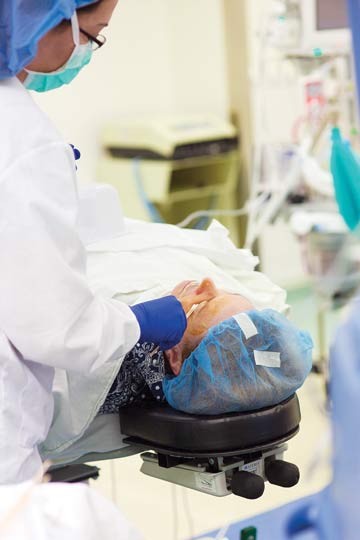Endophthalmitis, an infection involving the entire eye, is a rare complication of invasive procedures such as cataract surgery and intravitreal injections. Post-cataract surgery endophthalmitis rates vary, depending on the source, but are estimated to approximate 0.1%. However, because more than 3.5 million cataract surgeries are performed annually in the United States, a sizeable number of patients are at risk. The same holds true for intravitreal injections, of which over 7 million are performed in the United States each year for conditions such as wet macular degeneration, diabetic macular edema and diabetic retinopathy. Although the risk of post-injection endophthalmitis is low — estimated to be between 1 in 2,000 and 1 in 5,000 — a significant number of patients have the potential to be affected.
Post-cataract surgery or post-injection endophthalmitis can happen no matter how careful physicians are during procedures, but there are ways to minimize the risks.
- Pre-operatively. Meibomian gland dysfunction or blepharitis should be optimized before surgery with lid hygiene management. Avoid concurrent nasolacrimal duct surgeries at the time of cataract surgery, as these procedures have been found to increase the risk of post-operative endophthalmitis.
- Prepping. Staphylococcus species bacteria are responsible for more than half of post-cataract endophthalmitis cases. Most of the bacteria live on eyelashes, eyelid margins and periorbital skin, stressing the importance of proper pre-operative prepping.
Generously apply 10% povidone-iodine to the periorbital area. I also like to "paint" individual eyelashes as if applying mascara. It's important to clean the lid margins well, especially if the patient has severe blepharitis. But take care not to scrub too vigorously, which could cause microscopic wounds to form. Use 5% povidone-iodine to irrigate the ocular surface.
When draping the eye, make sure the eyelashes are fully covered. A speculum will help move the lashes and eyelids away from the ocular working surface. If patients declare an allergy to povidone-iodine, I generally inquire further and emphasize the importance of its use, because true allergies to povidone-iodine are extremely rare. While chlorhexidine gluconate can be used in its place, it is definitely a second-line agent, and is not quite as effective in reducing the bacterial load in and around the eye.
- Keep the bag intact. Rupturing the capsular bag during cataract surgery increases the risk of post-operative endophthalmitis. Thanks to ever-improving fluidic control on phacoemulsification machines as well as lens fragmentation devices and technology, the estimated risk of posterior capsule rupture is less than 1%. Being proactive in preventing this surgical complication is paramount in minimizing the patient's risk of endophthalmitis. For instance, in patients with floppy iris syndrome and poor dilation, consider pupillary expansion devices or pharmaceutical agents to maintain mydriasis so that visualization remains optimal throughout the entire case.
- Wound integrity. Corneal wound gaping can allow microorganisms to enter the intraocular space, increasing the risk of post-operative infection. Always check your wounds at the end of the case, especially if any concurrent surgery (pars plana vitrectomy or a glaucoma procedure, for example) was performed. I always tell my trainees who doubt the integrity of a wound to place a suture through it.
- Antibiotics. There is growing evidence supporting the benefit of intracameral antibiotics in the prevention of post-cataract endophthalmitis. A large 2007 randomized prospective study conducted by the ESCRS Endophthalmitis Study Group showed that intracameral cefuroxime with or without topical levofloxacin drops decreased the incidence of post-cataract endophthalmitis from 0.35% to 0.08% in more than 16,500 cataract patients, a significant positive finding that resulted in early termination of the study due to obvious benefit (osmag.net/SxuE3J).
Surgeons should always discuss the symptoms of endophthalmitis with their patients, especially those who are high-risk.
Intracameral moxifloxacin also appears to be effective in reducing the rate of endophthalmitis, according to a 2017 retrospective study of more than 600,000 surgeries that was published in Ophthalmology (osmag.net/ TFngS7). Moxifloxacin is preferred by some surgeons given its accessibility and due to the concern for hemorrhagic occlusive retinal vasculitis (HORV), a severe vision-threatening inflammatory reaction associated with use of intracameral vancomycin.
There are still no FDA-approved intracameral antibiotics on the market, so surgeons who choose to use these drugs must either compound the medication on site or purchase compounded formulations from an outside pharmacy. To ensure that your intracameral antibiotics are safely and properly prepared, partner with an accredited compounding pharmacy that is compliant with current Good Manufacturing Practices (cGMP) and has a track record of safety.
- Post-op drops. Although there is no level 1 evidence supporting the use of post-operative antibiotic drops, many surgeons do still prescribe them. Surgeons should always discuss the signs and symptoms of endophthalmitis with their patients, especially those who are at greater risk for developing this complication. Remember that patients with endophthalmitis classically present with pain, redness, floaters, blurry vision or a combination of those symptoms. Endophthalmitis often manifests within a week of cataract surgery, although it can also occur sooner or much later in the post-operative period.
.svg?sfvrsn=be606e78_3)

.svg?sfvrsn=56b2f850_5)